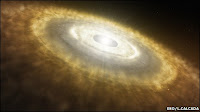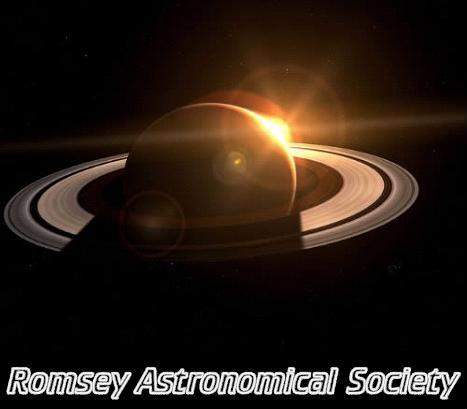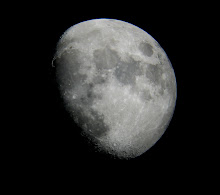Max Alexander has composed an audio/photographic homage to astronomers everywhere and can be viewed here
http://news.bbc.co.uk/1/hi/sci/tech/8319044.stm
The work was supported by the STFC and RAS
Tuesday 24 November 2009
Sunday 22 November 2009
Astronaut Becomes Father in Space
A US astronaut on board the space shuttle Atlantis is literally walking on air, with the news of the birth of a daughter back on Earth.
Randolph Bresnik, who is on his first space flight, became a father for a second time when baby Abigail was born back home in Houston, Texas. The event makes Bresnik the second astronaut to become a father in space - the first was Mike Fincke in 2004.
Mr Bresnik is due to return to Earth on Friday after an 11-day mission.
The 42-year-old Marine and his crewmates were awoken on Sunday by the song Butterfly Kisses, especially chosen by his wife, Rebecca.
Among the lyrics are the lines: "There's two things I know for sure, she was sent here from heaven and she's daddy's little girl."
The couple have a three-year-old son, who they adopted from Ukraine.
Randolph Bresnik, who is on his first space flight, became a father for a second time when baby Abigail was born back home in Houston, Texas. The event makes Bresnik the second astronaut to become a father in space - the first was Mike Fincke in 2004.
Mr Bresnik is due to return to Earth on Friday after an 11-day mission.
The 42-year-old Marine and his crewmates were awoken on Sunday by the song Butterfly Kisses, especially chosen by his wife, Rebecca.
Among the lyrics are the lines: "There's two things I know for sure, she was sent here from heaven and she's daddy's little girl."
The couple have a three-year-old son, who they adopted from Ukraine.
Saturday 14 November 2009
24 Hours gone!
Well...its been an exciting 24 hours.
The south coast has been battered by severe weather, wind gusts hitting 100mph in certain areas, which meant cause for concern for our recently built run off roof observatory but despite our concerns the 100mph winds and the week previous tornado strike could not budge our sturdy observatory, scope and home are doing well :-)
Imagine our surprise then when after all this bad weather we looked out and were greeted with clear skies....observing started straight away.
Members tonight have completed a series of observations of variable stars including assisting on projects as requested to do so by the American Association of Variable Star Observers (AAVSO) monitoring some important changes that have been noted in recent days. Variable star observation count has nearly hit the 500 mark already!!
M76, M100, NGC7226 & M45 were also observed and recorded with members sketching their observations, these notes will be on their way to both the British Astronomical Association and Society for Popular Astronomy as soon as possible
Thanks to all members who attended the observing session tonight....a great time was had by all inlcuding the groups two youngest members Sharon (8 years) and Martin (10 years)
The south coast has been battered by severe weather, wind gusts hitting 100mph in certain areas, which meant cause for concern for our recently built run off roof observatory but despite our concerns the 100mph winds and the week previous tornado strike could not budge our sturdy observatory, scope and home are doing well :-)
Imagine our surprise then when after all this bad weather we looked out and were greeted with clear skies....observing started straight away.
Members tonight have completed a series of observations of variable stars including assisting on projects as requested to do so by the American Association of Variable Star Observers (AAVSO) monitoring some important changes that have been noted in recent days. Variable star observation count has nearly hit the 500 mark already!!
M76, M100, NGC7226 & M45 were also observed and recorded with members sketching their observations, these notes will be on their way to both the British Astronomical Association and Society for Popular Astronomy as soon as possible
Thanks to all members who attended the observing session tonight....a great time was had by all inlcuding the groups two youngest members Sharon (8 years) and Martin (10 years)
Friday 13 November 2009
Rosetta Probe makes last fly by

Europe's Rosetta probe is making its third and final flyby of Earth as it seeks to position itself to chase down a comet in 2014.
The spacecraft's whip around the planet will give it the extra speed it needs to take it out to the rendezvous location near Jupiter.
Launched in 2004, Rosetta has already flown by Earth twice and Mars once.
The journey out to Comet 67P/Churyumov-Gerasimenko will also take the probe past an asteroid in 2010.
Rosetta is expected to be moving at some 13.3km/s as it sweeps over the Indian Ocean, just south of the Indonesian island of Java.
At closest approach, timed currently to be 0745GMT, it should be at an altitude of just 2,481km, well inside the orbits of geostationary telecoms satellites.
Rosetta needs the gravity assist of passing close to Earth
Engineers say the gravity-assist will increase Rosetta's speed by 3.6km/s with respect to the Sun. Scientists will use the flyby to test the health of some of Rosetta's instruments by making observations of the Earth and the Moon.
Osiris, the main scientific camera system, will be taking pictures.
Rosetta will be extremely difficult to see from the ground, and amateur astronomers have been told that large telescopes will be required to pick up the faint, fast-moving object.
Engineers will assess the probe's trajectory after the Earth-Moon flyby sequence has been completed, to see if any course corrections are required. Any changes will be easier and lighter on fuel if they are made as early as possible.
The mission is expected to make a flyby of Asteroid Lutetia in July 2010, but apart from that one event the long journey into the outer Solar System should be a quiet one.
Indeed, for much of the time, the spacecraft will be put in a hibernation mode.
Rosetta's meeting with Churyumov-Gerasimenko is set for the May of 2014.
The probe will go into orbit around the 4km-wide ball of ice and dust and place a small lander called Philae on its surface.
As the comet moves into the inner Solar System, radiation from the Sun will cause the comet's ices to sublime - they will turn straight from a solid to a gas. Material will be ejected at supersonic speeds.
Gas and dust will be thrown out around the comet to form a coma, and away from the comet to form tails.
The Rosetta orbiter and lander will watch and record these events as the comet hurtles along at speeds up to 135,000km/h.
Scientists are keen to study comets close up because they are thought to contain materials that have remained largely unchanged since the formation of the Solar System 4.6bn years ago.
Rosetta milestones:
• Launch: 2 March 2004
• First Earth swingby: 4 March 2005
• Mars swingby: 25 February 2007
• Second Earth swingby: 13 November 2007
• Steins flyby: 5 September 2008
• Third Earth swingby: 13 November 2009
• Lutetia flyby: 10 July 2010
• Comet rendezvous manoeuvres: 22 May 2014
• Lander delivery: 10 November 2014
• Escorting the comet around the Sun: November 2014 - December 2015
• End of mission: December 2015
Thursday 12 November 2009
Lithium clues for planet hunters

Astronomers may have found a way to identify those Sun-like stars most likely to harbour orbiting planets.
A survey of stars known to possess planets shows the vast majority to be severely depleted in lithium.
To date, scientists have detected just over 420 worlds circling other stars using a range of techniques.
Garik Israelian and colleagues tell the journal Nature that future planet hunts could be narrowed by going after stars with particular compositions.
Scientists think events early in the star's formation may be responsible for producing the lithium phenomenon.
Theory holds that planets grow from a disc of dusty material that develops around infant stars.
The researchers propose that this disc and its contents alter the young star's spin, mixing its upper layers more effectively into the interior where its contents can be "burnt" in the fusion processes that power it.
"When discs form around stars there is interaction of angular momentum between disc, planets and parent star; and this interaction affects the rotation of the parent star and that will affect the lithium abundance," said Garik Israelian from the Instituto de Astrofisica de Canarias, Tenerife, Spain.
The relative low abundance of lithium in our Sun's upper layers has long been a fascination for scientists.
Researchers who have studied meteorites with compositions unchanged since the beginning of the Solar System say the element's presence in our star ought to be 140 times greater than is observed.
Physicists know the Sun's upper layers as viewed today do not convect deeply enough to take any lithium to a location that is sufficiently hot to burn the element. This suggests mixing conditions must have been different in the past.
The outcome of the research is a tool astronomers can now use to help pinpoint the right type of stars where they are likely to detect planets.
"Suppose you had 50 or 100 candidates for parent-bearing stars," explained Dr Israelian.
"Those which have a very low abundance of lithium will be the best candidates around which you might find planets," he told BBC News.
Astronomers detect exoplanets, as they are called, using a number of methods.
One technique looks for the gravitational "wobble" a massive planet will induce in its parent star.
Another approach is to monitor a star for extended periods in the hope a planet will pass across its face. This transit reveals the planet's presence by making the star's light dim ever so slightly.
(This news from www.bbc.co.uk)
Monday 2 November 2009
Apollo landing site.....a closer view!
This should quieten all those critics saying the lunar landings were faked
Nasa's Lunar Reconnaissance Orbiter is now in a 50km-high orbit around the Moon and has been able to resolve Apollo 17 hardware. The image shows the descent stage left on the Moon's surface by Jack Schmitt's and Gene Cernan's Lunar Module. Even the flag they planted is just visible.
Developments in Amateur Astronomy: Past, Present & Future
A meeting in honour of Sir Patrick Moore to celebrate 75 years as a BAA member.


Join Sir Patrick at The Royal Institution , London, to share in this special celebration of amateur astronomy, past present and future. To book download this Booking Form , complete and return with payment to the BAA Office, by 31st October 2009.
Speakers to include
The Craters of the Moon: From Pre-Apollo to Lunar Reconnaissance Orbiter - Sir Patrick Moore and Dr. Peter Catermole.
The Virtual Observatory and Data Mining - Prof. Andy Lawrence, ROE.
Discovering Variable Stars and Transiting Exoplanets - Stan Waterman
Leading-Edge Imaging Sensor Technologies for the Amateur Astronomer: Today and Tomorrow - Karen Holland, X-Cam
Amateur Spectroscopy: Dawn of a New Age - Robin LeadbeaterAstrophotography with your Digital SLR - Tony Morris
New Opportunities for Observing Asteroids and Comets - Dr. Richard Miles
Splitting the Arcsecond: 21st Century Planetary Imaging - Martin Mobberley
High Precision CCD Photometry & Pro-Am Collaboration in Variable Star Research - Dr. David Boyd
Imaging the Deep Sky - Dr. Nick Hewitt
Remote and Robotic Observing - Nick James
Venue: The Royal Institution, Albemarle Street, London, W1
Date: Saturday 21st November 2009
Price including all talks and refreshments £10 per person for BAA Members, £15 per person for non-members.
This meeting is being generously supported by a grant from the Royal Astronomical Society.


Join Sir Patrick at The Royal Institution , London, to share in this special celebration of amateur astronomy, past present and future. To book download this Booking Form , complete and return with payment to the BAA Office, by 31st October 2009.
Speakers to include
The Craters of the Moon: From Pre-Apollo to Lunar Reconnaissance Orbiter - Sir Patrick Moore and Dr. Peter Catermole.
The Virtual Observatory and Data Mining - Prof. Andy Lawrence, ROE.
Discovering Variable Stars and Transiting Exoplanets - Stan Waterman
Leading-Edge Imaging Sensor Technologies for the Amateur Astronomer: Today and Tomorrow - Karen Holland, X-Cam
Amateur Spectroscopy: Dawn of a New Age - Robin LeadbeaterAstrophotography with your Digital SLR - Tony Morris
New Opportunities for Observing Asteroids and Comets - Dr. Richard Miles
Splitting the Arcsecond: 21st Century Planetary Imaging - Martin Mobberley
High Precision CCD Photometry & Pro-Am Collaboration in Variable Star Research - Dr. David Boyd
Imaging the Deep Sky - Dr. Nick Hewitt
Remote and Robotic Observing - Nick James
Venue: The Royal Institution, Albemarle Street, London, W1
Date: Saturday 21st November 2009
Price including all talks and refreshments £10 per person for BAA Members, £15 per person for non-members.
This meeting is being generously supported by a grant from the Royal Astronomical Society.
Subscribe to:
Posts (Atom)


